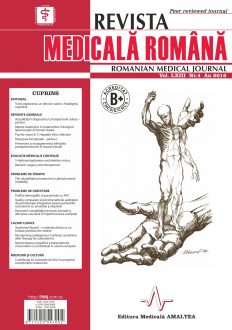SELECT ISSUE

Indexed

| |

|
|
|
| |
|
|
|

|
|
|
|
|
|
|
HIGHLIGHTS
National Awards “Science and Research”
NEW! RMJ has announced the annually National Award for "Science and Research" for the best scientific articles published throughout the year in the official journal.
Read the Recommendations for the Conduct, Reporting, Editing, and Publication of Scholarly work in Medical Journals.
The published medical research literature is a global public good. Medical journal editors have a social responsibility to promote global health by publishing, whenever possible, research that furthers health worldwide.
Recognizing endogenous Cushing’s syndrome after therapy for scleroderma
Ana Valea, Dan Nicolae Paduraru, Adriana Elena Nica, Maria Iuliana Oprisor, Adina Ghemigian and Mara Carsote
REZUMAT
Introduction. Scleroderma induces heterogeneous skin changes due to collagen anomalies, including facial. The recommended therapy is, among others, topic cortisol derived products, so an issue of diagnosis differential regarding the etiological type of Cushing’s syndrome (CS) is raised if a patient develops a suggestive phenotype.
Case presentation. This is a 64-year female presenting (since the last few months) red face, high blood pressure, central obesity. She has a 6-year history of scleroderma, intermittently treated with local corticotherapy. On admission, she associated metabolic disturbances as lipid profile anomalies, high uric acid, insulin resistance and increased number of white blood cells (which were not connected with a relapse of scleroderma, neither to an inflammatory syndrome). Low baseline plasma ACTH and morning serum cortisol level (not high, yet detectable) with abnormal diurnal rhythm suggested an adrenal source of CS. A 3 cm right adrenal tumor was found on computer tomography and later removed through a classical intervention. Two weeks after, the patient voluntarily reduced her prednisone dose causing an adrenal crisis which required re-admission as an emergency. After discharge, daily oral adrenal replacement therapy is needed for the moment.
Conclusions. Scleroderma, especially with skin involvement, and some of associated therapies may mask an endogenous CS as adrenal tumor derivate, thus delaying the adequate diagnosis and therapy. Patient’s
education regarding a potential life threatening condition as chronic adrenal insufficiency is necessary since post-operatory recovery of adrenal function is expected within 6 to 24 months.
Cuvinte cheie: Cushing’s syndrome, adrenal tumor, scleroderma
Full text | PDF
